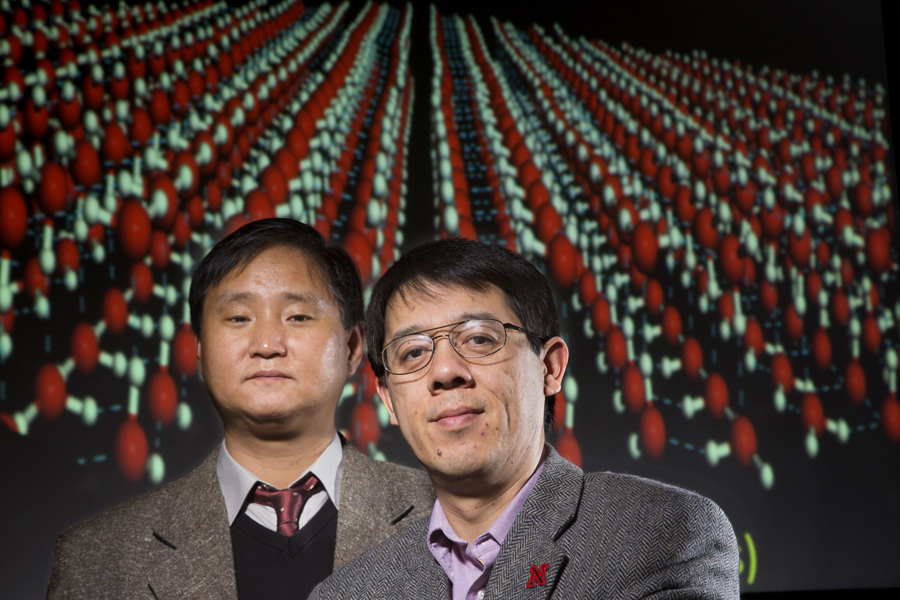
"Nebraska Ice" is the discovery that just keeps on giving for chemist Xiao Cheng Zeng and his UNL research team.
Modeled by Zeng's lab in 1997 and confirmed by laboratory researchers in the Department of Energy's Pacific Northwest National Laboratory in Richland, Wash., in 2009, Nebraska Ice is the nickname for a startling discovery that water contracts rather than expands when it is frozen at extremes of subnanoscale confinement. A two-dimensional form 0.8 billionth of a meter thick, the ice is as flat as flat can be -- thus its moniker. It's technical name is Two Dimensional Bilayer Ice I.
Thanks to research that grew out of that discovery, Zeng and his colleagues went on to publish two more papers in two of the highest-impact scientific journals based on Nebraska Ice, one in Nature (2001) and one in the Proceedings of the National Academy of Science (2010). This week, Zeng and research assistant professor Jaeil Bai add to that total with a paper in the Dec. 10-14 online edition of PNAS. The article details three separate discoveries made in a series of computer experiments directly related to Nebraska Ice using the University of Nebraska's Holland Computing Center.
One is a two-dimensional ice glass formed by applying lateral pressure equivalent to 30,000 atmospheres to Nebraska Ice. The resulting amorphous form had no long-range crystalline order in the water molecules, which instead formed a jumble of squares to pentagons. The significance here, Zeng said, is that because the hydrogen bonds connecting the water molecules form a diamond pattern in normal ice, similar to those found in carbon diamond and silicon, this two-dimensional ice amorphous discovery can thus provide a window into the much more complex glassy behavior of those elements at the two-dimensional thin-film level. That knowledge could help advance their use in solar panels, protection for computer hard disks and even the bottoms of ships, where cheap, environmentally benign carbon coatings could prevent corrosion from seawater.
The second discovery is a new two-dimensional bilayer ice form. Three-dimensional ice has 15 crystalline forms, but only one was known for the two-dimensional bilayer Nebraska Ice, so Bai and Zeng subjected it to lateral pressure equivalent to 60,000 atmospheres. The ice this time transformed into a square nanotube array, demonstrating a second crystalline form for Nebraska Ice.
The third discovery is something of a "grandchild" of Nebraska Ice, growing as it did out of the PNAS paper that Zeng, Bai and C. Austen Angell of Arizona State University published in 2010 about the discovery of a two-dimensional monolayer ice clathrate (a clathrate is essentially a network of molecular cages, usually three-dimensional in nature, in which molecules of one substance are completely enclosed in the crystal structure of another). The earlier discovery involved a computer experiment with monolayer Nebraska Ice where water-resistant argon atoms filled octagonal cages in the ice clathrate. For the new experiment, however, they decided to use two layers of Nebraska Ice, allowing them to substitute much larger methane molecules for the argon.
After a computer simulation that lasted nearly six months, Bai and Zeng found that the Nebraska Ice and methane would form a bilayer clathrate. That's significant for two main reasons, Zeng said. One is that three-dimentional methane hydrates buried in seabeds around the world are potentially immense energy sources, estimated by the Department of Energy to provide as much as 20,000 terawatt-years of energy, compared to the 1,000 terawatt-years estimated to remain in conventional oil and gas. A second is that gas clathrates tend to form in deepwater oil and gas pipelines and block the flow. Again, he said, the two-dimensional study should provide insights into understanding the properties of the more complex three-dimensional gas hydrate materials and help prevent blockages.
"I came here as an assistant professor 20 years ago and I started to do research on water and ice, year after year," said Zeng, Ameritas University Professor of Chemistry. "I'm still amazed by its fascinating properties. Water is kind of an exquisite artwork of Mother Nature, and that's no exaggeration.”
"Each discovery gives us new excitement, but it also raises more questions. That's why water fascinates me. It amazes me every time we create something new that we're not expecting."
It's the 11th time in as many years (and the third time this year) that work in Zeng's lab has been published in one of the four highest-impact interdisciplinary journals -- Nature, Science, PNAS and Nature Communications. Research for this week's paper was supported by grants from the National Science Foundation, the Army Research Laboratory, the Nebraska Research Initiative and the Holland Computing Center.
— Tom Simons, University Communications